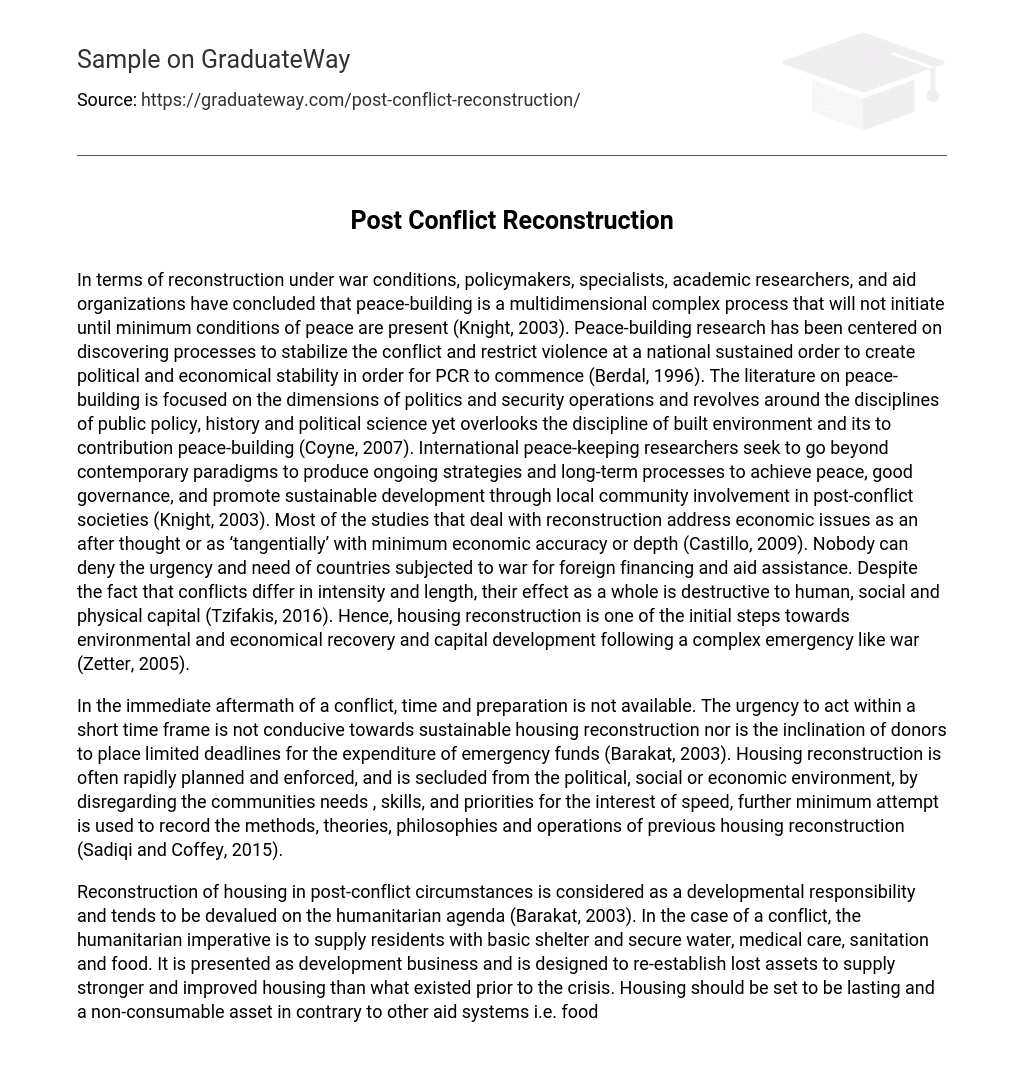In terms of reconstruction under war conditions, policymakers, specialists, academic researchers, and aid organizations have concluded that peace-building is a multidimensional complex process that will not initiate until minimum conditions of peace are present (Knight, 2003). Peace-building research has been centered on discovering processes to stabilize the conflict and restrict violence at a national sustained order to create political and economical stability in order for PCR to commence (Berdal, 1996). The literature on peace-building is focused on the dimensions of politics and security operations and revolves around the disciplines of public policy, history and political science yet overlooks the discipline of built environment and its to contribution peace-building (Coyne, 2007). International peace-keeping researchers seek to go beyond contemporary paradigms to produce ongoing strategies and long-term processes to achieve peace, good governance, and promote sustainable development through local community involvement in post-conflict societies (Knight, 2003). Most of the studies that deal with reconstruction address economic issues as an after thought or as ‘tangentially’ with minimum economic accuracy or depth (Castillo, 2009). Nobody can deny the urgency and need of countries subjected to war for foreign financing and aid assistance. Despite the fact that conflicts differ in intensity and length, their effect as a whole is destructive to human, social and physical capital (Tzifakis, 2016). Hence, housing reconstruction is one of the initial steps towards environmental and economical recovery and capital development following a complex emergency like war (Zetter, 2005).
In the immediate aftermath of a conflict, time and preparation is not available. The urgency to act within a short time frame is not conducive towards sustainable housing reconstruction nor is the inclination of donors to place limited deadlines for the expenditure of emergency funds (Barakat, 2003). Housing reconstruction is often rapidly planned and enforced, and is secluded from the political, social or economic environment, by disregarding the communities needs , skills, and priorities for the interest of speed, further minimum attempt is used to record the methods, theories, philosophies and operations of previous housing reconstruction (Sadiqi and Coffey, 2015).
Reconstruction of housing in post-conflict circumstances is considered as a developmental responsibility and tends to be devalued on the humanitarian agenda (Barakat, 2003). In the case of a conflict, the humanitarian imperative is to supply residents with basic shelter and secure water, medical care, sanitation and food. It is presented as development business and is designed to re-establish lost assets to supply stronger and improved housing than what existed prior to the crisis. Housing should be set to be lasting and a non-consumable asset in contrary to other aid systems i.e. food and water, yet its reconstruction is poor in relation to relief aid organizations. Therefore, it is required to increase the focus of housing reconstruction as a process, and not as an asset or capital control as well as apply reconstruction approaches to enhance human development (Vahanvati, 2018). Previous housing provisions have ignored the local communities preferences, skills, and priorities for the sake of speed (Barakat, 2003). According to Davis (1986) the architect behind the twelve principles of reconstruction planning in post-war environments, in his fourth principle states that the dichotomy of housing reconstruction and sustainable development is through local public engagement and recommends to “Always assess and rebuild the building industry before rebuilding towns and cities”. Therefore, it is necessary to research the local construction industry in terms of building materials and development which was disregarded in previous housing projects which lead to its insufficiency (Minervini, 2002). Further, it is advised that investing in social capital is the key principal to achieve sustainable recovery in affected regions. Currently, aid agencies and reconstruction organizations focus on execution of programmes that are solely technical solutions with no social account, thus is one of the leading causes of weak housing recovery (Nilssen, 2001).





